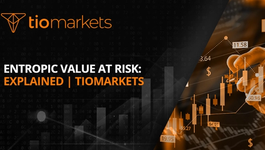The Rise of Stablecoins: Benefits and Risks for Traders
BY TIOmarkets
|May 24, 2024In recent years, stablecoins have emerged as a popular choice for traders in the cryptocurrency market. These digital currencies are designed to provide stability in an otherwise volatile market, making them an attractive option for both experienced traders and newcomers alike. But what exactly are stablecoins, and what benefits and risks do they bring? In this article, we will explore the rise of stablecoins, understand their function, analyze their growing popularity, discuss the advantages they offer to traders, and examine the potential risks and challenges they pose. Finally, we will take a look at the future of stablecoins and how they are likely to shape the trading landscape.
Understanding Stablecoins
Definition and Function of Stablecoins
Stablecoins are a type of cryptocurrency that aims to maintain a stable value, usually by being pegged to a reserve asset, such as a traditional currency like the US dollar or a commodity like gold. Unlike volatile cryptocurrencies like Bitcoin or Ethereum, stablecoins offer traders a sense of stability and predictability, as their value remains relatively constant.
Stablecoins play a crucial role in the cryptocurrency market by providing a reliable medium of exchange and a store of value. Traders and investors often use stablecoins as a safe haven during times of market turbulence, allowing them to quickly move funds without being exposed to the extreme price fluctuations common in other cryptocurrencies.
Different Types of Stablecoins
There are several types of stablecoins, each with its own unique characteristics and mechanisms. Some stablecoins are fully collateralized, meaning that they hold 1:1 reserves of the underlying asset they are pegged to. This ensures that the stablecoin can always be redeemed for its pegged asset, instilling trust and confidence among users.
On the other hand, algorithmic stablecoins rely on complex algorithms and smart contracts to adjust the coin's supply dynamically in response to market demand. This mechanism helps stabilize the coin's price without the need for full collateralization, offering a more flexible and scalable solution.
Furthermore, there are stablecoins that are backed by a basket of assets, such as a mix of fiat currencies, commodities, and other cryptocurrencies. This diversified approach helps mitigate risk and reduce exposure to volatility in any single asset. Investors benefit from the added security and stability provided by this asset-backed model, making these stablecoins an attractive option for risk-averse market participants.
The Growing Popularity of Stablecoins
Factors Driving the Rise of Stablecoins
Several factors have contributed to the increasing popularity of stablecoins in the financial market. One of the main drivers is the desire for stability in the highly volatile cryptocurrency market. With stablecoins, traders can mitigate the risks associated with sudden price fluctuations and confidently engage in transactions without the fear of losing value.
Moreover, stablecoins are backed by reserves, which can include fiat currency, commodities, or other cryptocurrencies. This backing provides users with a sense of security and transparency, knowing that the value of the stablecoin is pegged to a tangible asset. This assurance has attracted a wide range of investors, from retail traders to institutional players, seeking a reliable store of value in the digital realm.
Stablecoins in the Current Financial Landscape
Stablecoins also offer a bridge between the traditional financial system and the world of cryptocurrencies. They provide a familiar and accessible form of digital currency that can be used for everyday transactions, making them appealing to both individuals and businesses. Furthermore, stablecoins offer a way to bypass the traditional banking system and facilitate cross-border transactions quickly and at a lower cost.
Additionally, the programmable nature of some stablecoins opens up a world of possibilities for developers and businesses looking to create innovative financial products and services. Smart contracts and decentralized applications (DApps) built on stablecoin platforms enable automated and trustless transactions, revolutionizing the way financial agreements are executed and enforced.
Advantages of Trading with Stablecoins
Stability and Security in Trading
Perhaps the most significant advantage of trading with stablecoins is the stability they provide. Traders can rely on their value remaining relatively constant, allowing for greater planning and risk management. Stablecoins also offer a secure and transparent way to conduct transactions, thanks to the underlying blockchain technology that ensures immutability and privacy.
Moreover, stablecoins are designed to be pegged to a stable asset, such as a fiat currency like the US dollar or a commodity like gold. This pegging mechanism helps in minimizing price volatility, which is a common concern in the cryptocurrency market. By using stablecoins, traders can avoid sudden price fluctuations and mitigate the risks associated with trading highly volatile cryptocurrencies.
Accessibility and Efficiency of Stablecoins
Stablecoins offer a level of accessibility that traditional financial systems often lack. Anyone with an internet connection can use stablecoins, regardless of their location or financial background. Furthermore, stablecoins streamline the trading process by eliminating intermediaries and reducing transaction costs, making them an efficient option for traders.
In addition, stablecoins provide a convenient way to transfer value across borders quickly and securely. Traditional cross-border transactions can be slow and expensive due to the involvement of multiple banks and payment processors. With stablecoins, users can send funds internationally within minutes, 24/7, without the need for extensive paperwork or high fees. This accessibility and efficiency make stablecoins an attractive option for individuals and businesses looking to engage in global trade and commerce.
Potential Risks and Challenges for Traders
Regulatory Concerns and Stablecoins
Despite their benefits, stablecoins have raised regulatory concerns in some jurisdictions. As stablecoins aim to mirror the value of traditional assets, they can be classified as securities or commodities, subjecting them to existing financial regulations. The lack of clear regulatory frameworks poses a challenge for traders and slows down widespread adoption.
Furthermore, the evolving nature of the cryptocurrency landscape adds another layer of complexity to the regulatory concerns surrounding stablecoins. Regulators are continuously grappling with how to categorize and oversee these digital assets, leading to a dynamic and uncertain environment for traders and investors alike. Navigating this intricate web of regulations requires a deep understanding of both traditional financial laws and emerging blockchain technologies.
Volatility and Market Risks
While stablecoins provide stability compared to other cryptocurrencies, they are not entirely immune to market risks. External factors, such as changes in the underlying asset value or disruptions in the reserve system, can impact the stability of stablecoins. Traders must remain vigilant and assess the risks associated with each stablecoin before engaging in trading activities.
Moreover, the interconnected nature of global financial markets introduces additional layers of complexity to the volatility risks associated with stablecoins. Factors such as geopolitical events, macroeconomic indicators, and investor sentiment can all contribute to sudden fluctuations in the value of stablecoins, challenging traders to stay ahead of the curve. Mitigating these market risks requires a comprehensive risk management strategy that takes into account both internal and external variables that could impact the stability of stablecoin investments.
Future of Stablecoins in Trading
Predicted Trends for Stablecoins
Looking ahead, stablecoins are likely to witness continued growth and innovation. We can expect to see increased adoption by both individual traders and institutional investors seeking stability and efficiency. Governments and central banks may also explore the idea of issuing their own stablecoins to leverage the benefits of blockchain technology while maintaining control over their monetary policies.
Impact on Traditional Trading Practices
The rise of stablecoins has the potential to disrupt traditional trading practices by offering a more efficient and accessible alternative. With increased liquidity and stability, traders can enjoy new opportunities and strategies. However, it is important to note that stablecoins are still in their early stages, and their impact on the broader financial ecosystem is yet to be fully realized.
In conclusion, stablecoins have emerged as a valuable tool for traders in the cryptocurrency market. By providing stability, accessibility, and security, they offer a compelling alternative to traditional cryptocurrencies. However, traders must be aware of the potential risks and challenges associated with stablecoins, such as regulatory concerns and market volatility. As the future of stablecoins unfolds, it is clear that they have the potential to reshape the trading landscape and offer new opportunities for traders worldwide.
Start Trading with Stablecoins on TIOmarkets
Ready to harness the power of stablecoins in your trading strategy? Join TIOmarkets, the top-rated forex broker with over 170,000 accounts opened across more than 170 countries. With our platform, you can trade over 300 instruments across 5 markets, including Forex, indices, stocks, commodities, and futures, all with low fees. Plus, elevate your trading skills with our comprehensive educational resources and step-by-step guides. Don't miss out on the opportunity to reshape your trading landscape with stablecoins. Create a Trading Account today and start your journey towards trading success.

Risk disclaimer: CFDs are complex instruments and come with a high risk of losing money rapidly due to leverage. You should consider whether you understand how CFDs work and whether you can afford to take the high risk of losing your money. Never deposit more than you are prepared to lose. Professional client’s losses can exceed their deposit. Please see our risk warning policy and seek independent professional advice if you do not fully understand. This information is not directed or intended for distribution to or use by residents of certain countries/jurisdictions including, but not limited to, USA & OFAC. The Company holds the right to alter the aforementioned list of countries at its own discretion.
CFDs are complex instruments and come with a high risk of losing money rapidly due to leverage. You should consider whether you understand how CFDs work and whether you can afford to take the high risk of losing your money. Never deposit more than you are prepared to lose. Professional client’s losses can exceed their deposit. Please see our risk warning policy and seek independent professional advice if you do not fully understand. This information is not directed or intended for distribution to or use by residents of certain countries/jurisdictions including, but not limited to, USA & OFAC. The Company holds the right to alter the aforementioned list of countries at its own discretion.
Join us on social media

Behind every blog post lies the combined experience of the people working at TIOmarkets. We are a team of dedicated industry professionals and financial markets enthusiasts committed to providing you with trading education and financial markets commentary. Our goal is to help empower you with the knowledge you need to trade in the markets effectively.
Related Posts





